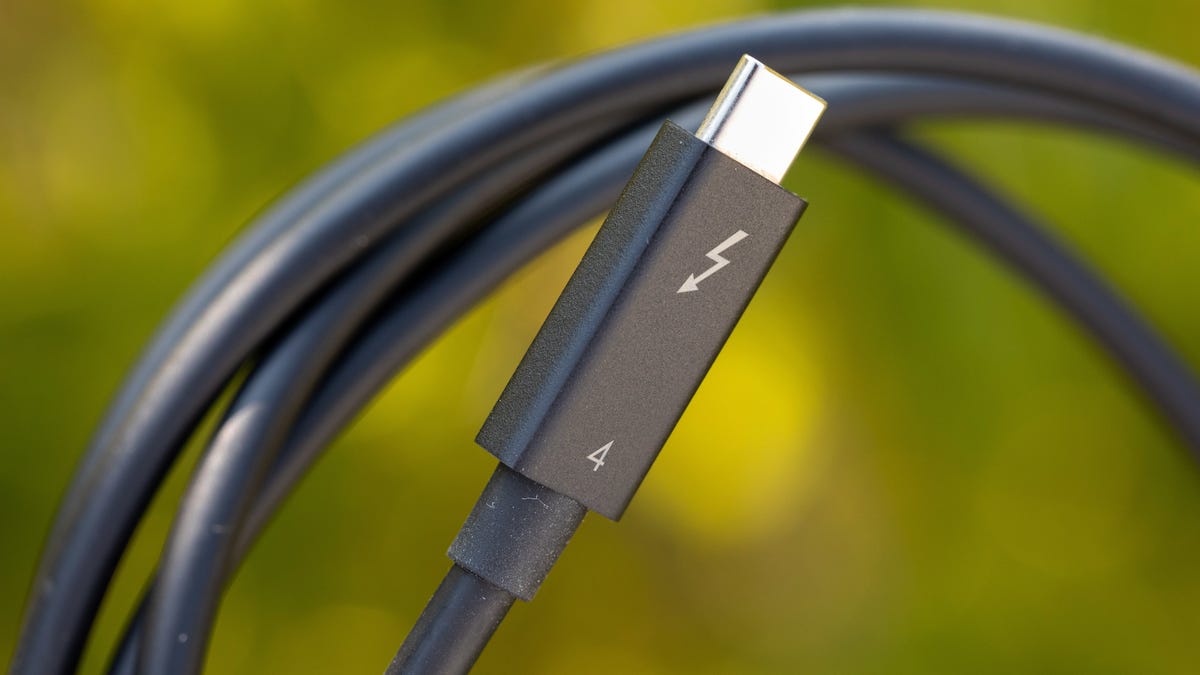Intel Promises Doubled Speeds, Peace of Mind With Next-Gen Thunderbolt
Thunderbolt is now basically a better tested version of USB 4 with faster guaranteed speeds. But it's still confusing for consumers.

A Thunderbolt 4 cable sports the Intel technology's lightning logo.
Intel on Wednesday began showing off a faster upcoming version of Thunderbolt, its technology for data transfer and charging. Like the USB 4 version 2 standard on which it's based, the new Thunderbolt version will reach a maximum speed of 80 gigabits per second under ordinary circumstances but can bump up to 120Gbps to handle high-resolution displays.
Thunderbolt and USB have had a complex history. Thunderbolt began as proprietary Intel technology that offered higher data transfer speeds, but Intel contributed the technology to the USB industry group. Thunderbolt now is essentially a more polished, tested version of USB. Its lightning logo indicates that a cable, docking station, port on the side of a PC, or other device has passed performance and compatibility testing at Intel certified labs.
With Thunderbolt, Intel is trying to assure you that things will work smoothly, with a minimum 40Gbps data transfer speed, support for dual 4K monitors, support for the DisplayPort connection technology for connecting to monitors, and the ability to carry up to 100W of power -- enough for most high-end laptops. USB 4 supports those options but doesn't require them.
With the future version of Thunderbolt, data transfer standards will require both the ability to transfer data at 80Gbps to and from a PC and the video-centric option of 120Gbps to monitors and 40Gbps back to the PC, said Jason Ziller, general manager of Intel's Client Connectivity Division.
Thunderbolt and USB 4 both play an increasingly important role in connecting laptops to peripherals. That can include large high-resolution 4K monitors, external storage systems, and high-speed network adapters. Those devices are all more useful these days as gamers and creative professionals move away from hulking desktop PCs to more convenient laptops.
All this port technology is something of a mess, though.
"We've discovered that the average consumer has minimal knowledge on the core differences between USB-C, Thunderbolt or USB 4," said Brock Guclu, president of peripheral maker Satechi. "Because all the ports look identical, most end users believe they all are the same type of port without realizing that they all can support different protocols and features."
Intel wouldn't say when the new Thunderbolt version will arrive, what it'll be called, or how it'll handle USB's newer high-power 240W charging technology for beefy gaming laptops. USB 4 version 2 products are expected to begin arriving in the next 12 to 18 months.
The new Thunderbolt also will support DisplayPort 2.1, an updated version of technology for connecting external monitors that's designed to get along better with USB. One of the key elements of USB 4 drawn from Thunderbolt is the ability to carry multiple types of data at once, including video data headed to an external monitor. Although DisplayPort has its own connector and port design, it also can use the oval USB-C port and USB-C cables.
USB and Thunderbolt both have maintained backward compatibility so you can plug older devices into a new PC's port and new devices into an old PC. That's essential, since people often only gradually update their hardware. Why replace that webcam if it still works?
The reality for many consumers, though, is a hodgepodge of cables and devices that often don't work at the highest speeds. Thunderbolt offers some help in that messy world, said Nick Brill, product development director at peripheral maker VisionTek.
"That's where Thunderbolt does have its advantages," Brill said. "You plug whatever you want into a Thunderbolt port, and odds are, it's going to work."

